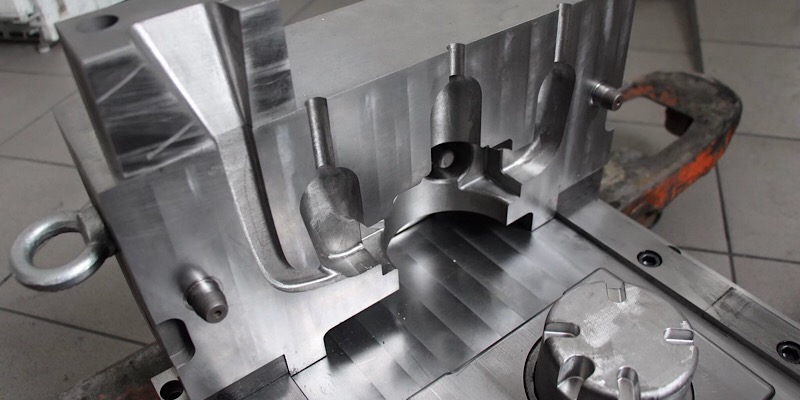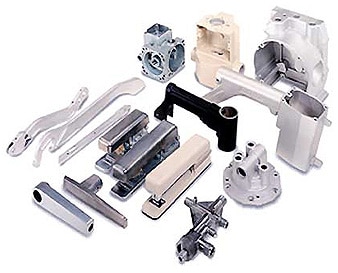How Wisconsin Aluminum Foundry delivers precision and reliability
Wiki Article
Everything About Light Weight Aluminum Castings: Comprehending Their Function and Significance in Production
Aluminum spreadings are essential to modern-day manufacturing, supplying a mix of light-weight residential properties and toughness. They promote complex styles while decreasing assembly prices. Industries such as aerospace and auto frequently use these components for boosted efficiency. The production of aluminum castings is not without its obstacles. Comprehending the subtleties of this procedure reveals both the advantages and potential pitfalls. Discovering these factors will provide much deeper insights into their growing value.Overview of Aluminum Spreading Processes
Light weight aluminum casting procedures play a vital function in production, supplying convenience and performance. These processes involve pouring molten light weight aluminum into molds to develop specific shapes and components. Different techniques are employed, consisting of sand casting, die spreading, and financial investment casting, each identified by its technique of mold and mildew development and the designated application.Sand spreading makes use of a blend of sand and binder to form molds, permitting for complicated geometries. Pass away spreading, on the various other hand, includes forcing molten light weight aluminum into steel mold and mildews, leading to high precision and smooth finishes. Financial investment spreading, frequently used for intricate styles, involves producing a wax pattern coated with a ceramic covering, which is after that full of liquified light weight aluminum.
These casting techniques cater to diverse industrial demands, making light weight aluminum a favored material for parts in markets such as auto, aerospace, and customer goods. The option of casting method considerably affects the last item's quality and efficiency.
Advantages of Utilizing Light Weight Aluminum Castings
The advantages of utilizing light weight aluminum castings in manufacturing are substantial and countless. To start with, light weight aluminum's lightweight nature adds to reduced overall item weight, enhancing energy performance in applications such as automotive and aerospace sectors. Additionally, light weight aluminum castings exhibit excellent deterioration resistance, ensuring long life and longevity in extreme environments. The material's thermal and electrical conductivity likewise makes it suitable for numerous applications, including electronic devices and warmth exchangers.On top of that, light weight aluminum castings can be produced with elaborate styles, permitting a lot more complicated shapes that fulfill details practical demands. This convenience contributes to reduced assembly expenses and enhanced style adaptability. The spreading process itself is reliable, allowing for high-volume manufacturing with consistent top quality. Aluminum is recyclable, making it an eco pleasant choice in manufacturing. Jointly, these advantages highlight why light weight aluminum spreadings are increasingly favored across diverse markets, offering both performance benefits and economic performance.
Typical Applications of Light Weight Aluminum Castings
While various products are used in production, aluminum spreadings stand out due to their broad range of applications across numerous industries. These castings are extensively used in the automotive sector for engine components, transmission housings, and structural parts, adding to lighter vehicles and boosted gas efficiency. In the aerospace industry, aluminum castings are essential for airplane parts, where weight decrease is important for performance and safety and security.Additionally, the electric sector utilizes aluminum castings for real estates and architectural elements in equipment, taking advantage of the material's exceptional conductivity. In customer items, aluminum spreadings can be discovered in products such as appliances and showing off devices, giving resilience and a modern visual. The construction industry uses aluminum castings in building elements, window frameworks, and components, showcasing their versatility and stamina. On the whole, aluminum spreadings play an indispensable duty in boosting product performance and efficiency throughout different industries.
Secret Production Techniques for Light Weight Aluminum Castings
The production of light weight aluminum castings depends on numerous strategies, with sand spreading and pass away casting being among one of the most famous. Sand casting entails creating molds from sand, permitting big elements and elaborate layouts. In contrast, pass away casting uses high-pressure shot of liquified aluminum into reusable mold and mildews, using accuracy and efficiency for mass manufacturing.Sand Spreading Refine
Sand casting stands as one of the most commonly utilized techniques for generating light weight aluminum castings, thanks to its convenience and cost-effectiveness. This procedure includes creating a mold and mildew from a mix of sand and a bonding agent, usually clay. Once the mold is ready, molten aluminum is poured into it, enabling the steel to fill up the tooth cavity. After cooling, the mold is broken away to expose the spreading. Sand casting accommodates complicated geometries and huge parts, making it appropriate for various applications. In addition, it enables easy alterations, enabling suppliers to change styles promptly. Nevertheless, the surface coating may need extra machining for accurate applications, ensuring the end product fulfills high quality criteria.Pass Away Spreading Approaches
Die spreading represents a very effective approach for creating light weight aluminum spreadings, identified by its ability to provide high accuracy and superb surface coating. This technique primarily involves compeling molten aluminum into a mold and mildew under high pressure, making certain that great details and intricate forms are caught accurately. There are 2 primary die spreading methods: hot chamber and chilly chamber. Warm chamber die casting is appropriate for alloys with low melting points and permits faster cycles, while chilly chamber pass away casting is suitable for high-temperature alloys, calling for separate melting systems. Both techniques enhance manufacturing prices and decrease product waste, making pass away casting a recommended option in markets such as automobile and electronics, where toughness and dimensional precision are critical.Sustainability in Light Weight Aluminum Casting Manufacturing
While the need for light weight aluminum castings remains to expand, makers are progressively prioritizing sustainability in their manufacturing processes. This shift is driven by the need to decrease ecological influence and save all-natural sources. Numerous companies are adopting recycling efforts, making use of scrap light weight aluminum, which especially lowers energy consumption and greenhouse gas discharges compared to key aluminum production. Additionally, developments in casting innovations are making it possible for much more effective usage of materials, reducing waste throughout the manufacturing procedure.Producers are also discovering green alternatives to conventional casting approaches, such as 3D printing and advanced mold and mildew modern technologies, which aid maximize resource usage. Wisconsin Aluminum Foundry. On top of that, applying lasting methods in supply chain management guarantees that raw materials are sourced properly. As an outcome, the light weight aluminum spreading industry is making strides toward an extra sustainable future, aligning with global environmental goals while satisfying the raising demand for high-performance aluminum products
Difficulties and Factors To Consider in Light Weight Aluminum Casting
Light weight aluminum casting presents various difficulties that manufacturers have to navigate to assure item integrity. Design intricacy can complicate the casting procedure, causing potential problems and boosted manufacturing time. In addition, maintaining strenuous top quality control criteria is important to meet the demands of precision and integrity in finished parts.
Style Intricacy Issues
Designing components for aluminum casting provides different complexities that designers should navigate to attain ideal results. One substantial difficulty is the demand for exact geometry; detailed designs can result in problems Aluminum Castings in mold and mildew production and enhanced danger of problems. Additionally, thermal properties of aluminum demand careful factor to consider of cooling rates, as irregular air conditioning can create bending. Wall thickness variations also present a challenge, as they can affect circulation features and structural stability. Engineers need to balance layout looks with manufacturability, making sure that features such as ribs and fillets are optimized for strength without making complex the spreading procedure. Ultimately, considerations concerning draft angles are necessary to promote mold launch, more complicating the style process. These variables jointly highlight the details entailed in aluminum casting style.Top Quality Control Difficulties
Achieving top notch aluminum castings includes steering a series of quality assurance obstacles that can substantially affect the final item. First, variants in raw material structure can result in variances in casting homes, making it necessary to assure material top quality. Second, the spreading procedure itself is prone to issues, such as porosity and shrinking, which can endanger architectural integrity. In addition, temperature level control during melting and pouring is important; changes can lead to unequal solidification, influencing dimensional accuracy. Detailed examination techniques, consisting of non-destructive screening, should be used to recognize defects early. Lastly, keeping rigorous procedure documentation and adherence to market standards is indispensable for traceability and quality control, highlighting the complex equilibrium required to generate dependable light weight aluminum spreadings in manufacturing.Future Patterns in Aluminum Spreading Technology
As manufacturers endeavor to boost effectiveness and sustainability, advancements in light weight aluminum casting technology are arising to fulfill these needs. One substantial trend is the integration of automation and expert system, which streamline production processes and enhance precision in casting procedures. These advancements lessen human mistake and maximize resource usage, eventually bring about set you back reductions.In addition, the fostering of sophisticated materials and alloys is improving the landscape. New formulations boost performance characteristics, such as corrosion resistance and light-weight residential or commercial properties, making aluminum castings much more functional throughout various sectors.
Lasting techniques are getting traction, with an emphasis on recycling and decreasing waste (Wisconsin Aluminum Foundry). Strategies such as 3D printing are likewise being discovered to produce complex geometries that were previously unattainable
Frequently Asked Questions

Exactly How Do Aluminum Castings Compare to Other Products?
Light weight aluminum spreadings provide benefits such as light-weight, rust resistance, and exceptional thermal conductivity contrasted to other materials. They are typically liked for applications requiring durability and effectiveness, particularly in aerospace and automotive industries.What Is the Life Expectancy of Light Weight Aluminum Castings?
The life expectancy of aluminum spreadings usually varies from 10 to half a century, relying on environmental conditions, usage, and upkeep. Their deterioration resistance and toughness contribute noticeably to their long-lasting efficiency in various applications.Can Aluminum Castings Be Recycled?
Yes, aluminum spreadings can be recycled. The reusing process is efficient, permitting for the healing of light weight aluminum without substantial loss of high quality, making it a sustainable choice in manufacturing and reducing ecological effect.What Security Measures Are Needed Throughout Light Weight Aluminum Casting?
During light weight aluminum casting, crucial safety steps include putting on appropriate personal protective equipment, making sure appropriate air flow, preserving devices, making use of fireproof products, and implementing risk-free dealing with procedures for molten metal to protect against accidents and injuries.Just How Do Temperature Adjustments Impact Aluminum Castings?
Temperature adjustments significantly affect light weight aluminum castings by affecting fluidity, solidification rates, and mechanical properties. Fast cooling can cause increased brittleness, while gradual cooling promotes much better structural honesty and minimizes the danger of flaws.Pass away casting, on the other hand, includes compeling molten aluminum into metal mold and mildews, resulting in high accuracy and smooth surfaces. The production of aluminum castings depends on different strategies, with sand casting and die spreading being amongst the most popular. Sand spreading stands as one of the most widely made use of methods for generating light weight aluminum castings, many thanks to its adaptability and cost-effectiveness. Pass away spreading stands for a very efficient approach for creating aluminum castings, identified by its capability to supply high accuracy and superb surface finish. While the demand for aluminum castings continues to expand, makers are increasingly prioritizing sustainability in their manufacturing processes.
Report this wiki page